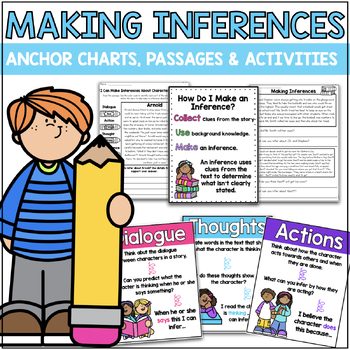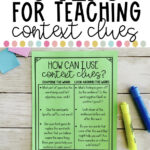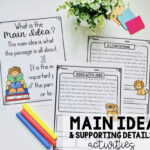HOw to teach students to make inferences
Are you wondering how to teach students to make inferences? Teaching students how to make inferences about the text they read can be TOUGH! This is because inferencing is not as direct as looking back into the text for answers. In order for students to infer they have to first find the evidence in the text and then determine what that evidence means using their own background knowledge or schema. Below I’ll give you a few tips you can use when teaching your students how to make inferences.
You can grab all of the activities that you see below (done for you!) in this resource: I Can Infer: Practice making inferences.
So, What is an inference?
An inference is a conclusion drawn from both background knowledge and clues from the text. Inferences help the reader understand things that aren’t explicitly said in the text, but the author wants the reader to know.
An example of inferencing may be that a character in the text really hates broccoli. The text never says, “Peter hates broccoli”, however when he finds out his mother is fixing it for dinner he gags. Then, at dinner, he slides some broccoli under the table for the family dog to eat. The author did not have to tell the reader about Peter’s hatred for broccoli. Peter’s actions related to broccoli showed how he felt about it instead. It’s the reader’s job to use his or her background knowledge as it relates to Peter’s actions to make an inference.
Having your students “read between the lines” can be extremely challenging.
Why teach inference?
Inferencing is not just re-stating what was said in the text. It is much more complex than that. Knowing how to infer means that students have a deeper level of comprehension and a better understanding of the text. As students grow in their reading, the complexity of the texts will also grow. It is important for students to think deeply about the texts they are reading in order to fully understand them.

Inferences vs. Predictions
Remind students that an inference is different than a prediction. An inference uses students background knowledge and clues from the text to determine what is happening. A prediction is a guess about what is going to happen. These can easily be confused
5 Tips and activities to Teaching Inferring
1. Use Pictures to Teach Inference
Using pictures to teach inferencing can be a great place to start rather than diving head first into a complex text. I love to use this as an opening activity for an inferencing unit because its so engaging for students! Asking students to give feedback about a text can be intimidating, but asking them to share their thoughts about an image is MUCH easier.
How to use pictures to teach students infer:
- Show students a picture, preferably one that will peak their interests.
- Ask them a few questions to get them thinking about what they see in the picture:
- What do you see in the picture?
- What do you think happened?
- What do you think is going on now?
What might the people in the picture be thinking?
Ask students specific questions to go along with the picture. For example, using the picture above you can ask : What is the cat trying to do? What could the cat be looking at?
You can find this picture and several others on the Picture Inferencing Task Cards inside my I Can Infer Activities Resource.
2.Riddles or What Am I? Activities
Another less intimidating activity to teach inferencing, is by give students riddles to solve. Riddles are perfect to give students practice inferring, because they provide just enough clues without giving away the answer.
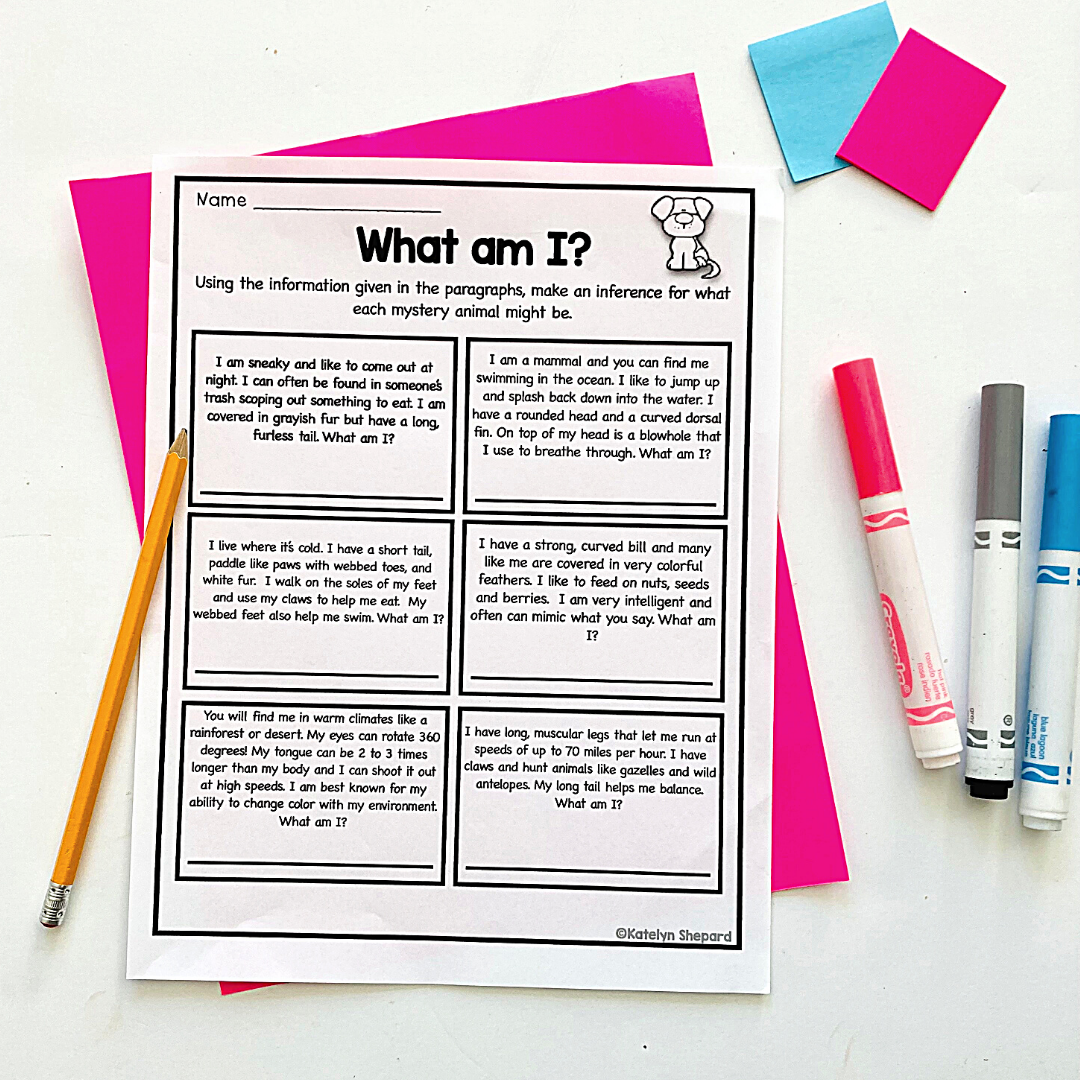
You can provide specific types of riddles like the “What Am I?” riddles inside of my I Can Infer Practice Making Inferences resource. Each riddle is about a specific animal. Students must use the clues provided to determine which animal it is. Here is an example from the “Mystery Places” activity also found in the inferencing resource:
I hear the sound of birds flying overheard.
My skin is red and starting to be a little sore.
I feel the hot sand underneath my feet and
hear other kids who are throwing a frisbee back and forth.
Where am I?
Students must determine where each mystery place is using their background knowledge and the clues provided in the riddles. These activities are super engaging for student because to them it feels like they are solving a mystery!
3. Use Question Stems
If we want our students to think more critically about the texts they are reading, it’s important to give them the tools to do so. Question stems are a great way to guide students’ thinking. I like to post question stems (for all subjects) on anchor charts around the classroom for students to refer to. After using them enough, many students eventually have them memorized. Here are a few question stems you can give to your students to help make inferences about any text:
- What do you already know about _______________? (Background Knowledge)
- What lesson does the author want the reader to learn from this text?
- How can you tell that _______________?
- Why did the author mention/ include ___________ in the text?
- What do you think _____________ was thinking when he/she said/did ______________?
4. Menor Texts to Teach Inferring
In order to effectively teach students to infer, you want to make sure you’re using good books to do it. Here are a few books that are great when it comes to teaching inferring in your classroom.
Two Bad Ants By Chris van allsburg

Two Bad Ants is a perfect book to introduce students to inferring. Students will use the pictures as well as the text to infer what the ants see as they crawl through the kitchen looking for sugar. I love using this book because it helps students gain confidence with inferring right from the beginning.
tesUsing this activity, students will identify specific pages throughout the story, infer what they believe the ants are seeing and then provide evidence for how they know this. This is a great activity to do the first inference together, two with partners and a third independently.
The Wretched Stone By Chris Van Allsburg 
The Wretched Stone is perfect for teaching students how to infer! It is told through the daily log of the captain of the Rita Ann. The sailors aboard this ship become mesmerized by a mysterious glowing stone they bring onboard. Students must use the evidence and images from the text to infer throughout different points of the text.
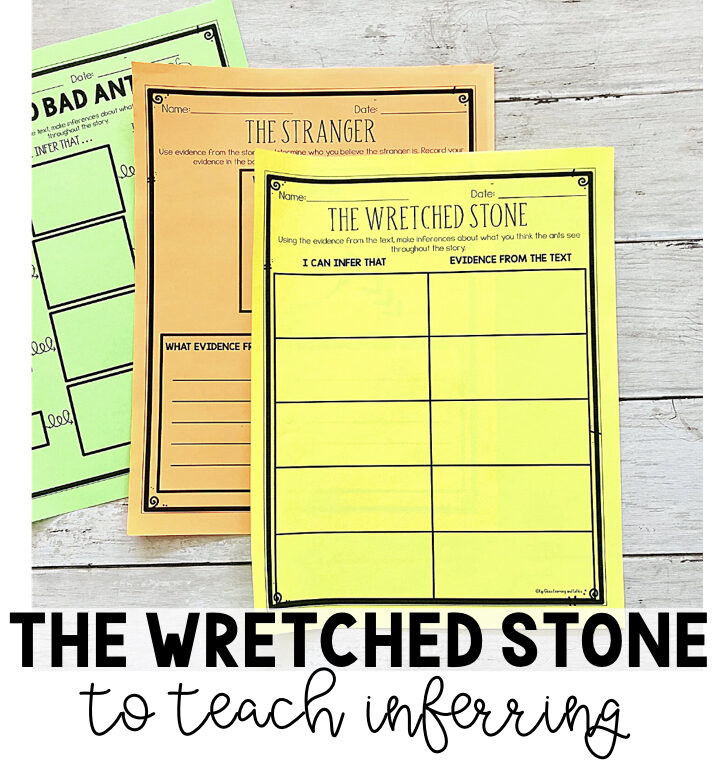 Students can use this activity to make inferences throughout the story, followed by providing evidence for each inference made. I would suggest guiding students through a few of these first, before having them complete this activity on their own.
Students can use this activity to make inferences throughout the story, followed by providing evidence for each inference made. I would suggest guiding students through a few of these first, before having them complete this activity on their own.
The Stranger By chris van allsburg

This Stranger is another excellent book to teach students to make inferences. While reading, students must figure out who this “stranger” is. This mysterious guest cannot talk, doesn’t have a temperature, and dislikes the green leaves on the trees. Students will love “reading between the lines” to infer who this stranger might be!
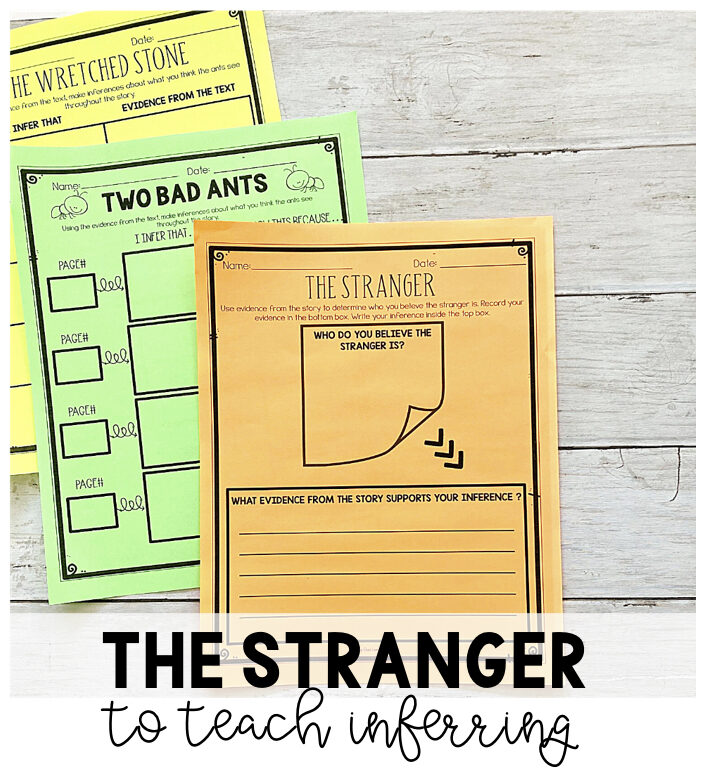
Your students will enjoy trying to determine who they believe the “stranger” could be. Using this activity, students will collect evidence while reading the story and then provide their inference. This activity gives students practice using evidence from the text to back up their inferences.
Do you want to grab these printables to use along with the books mentioned above? Simply fill out your information in the box below and they will be sent to your inbox for free!

CLICK HERE to grab all of the activities mentioned above in this resource: I Can Infer: Practice making inferences. 